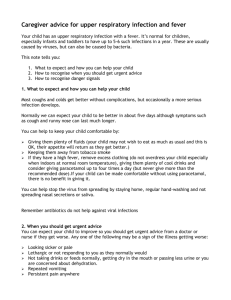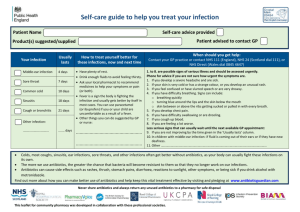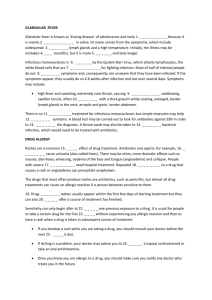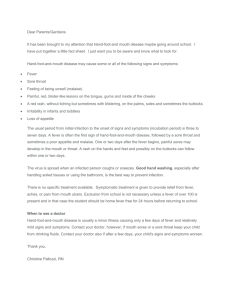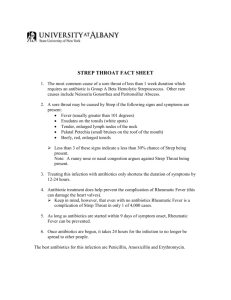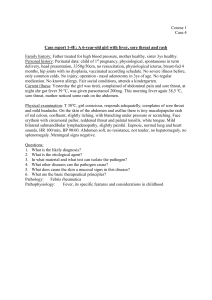INFECTIOUS DISEASES
advertisement
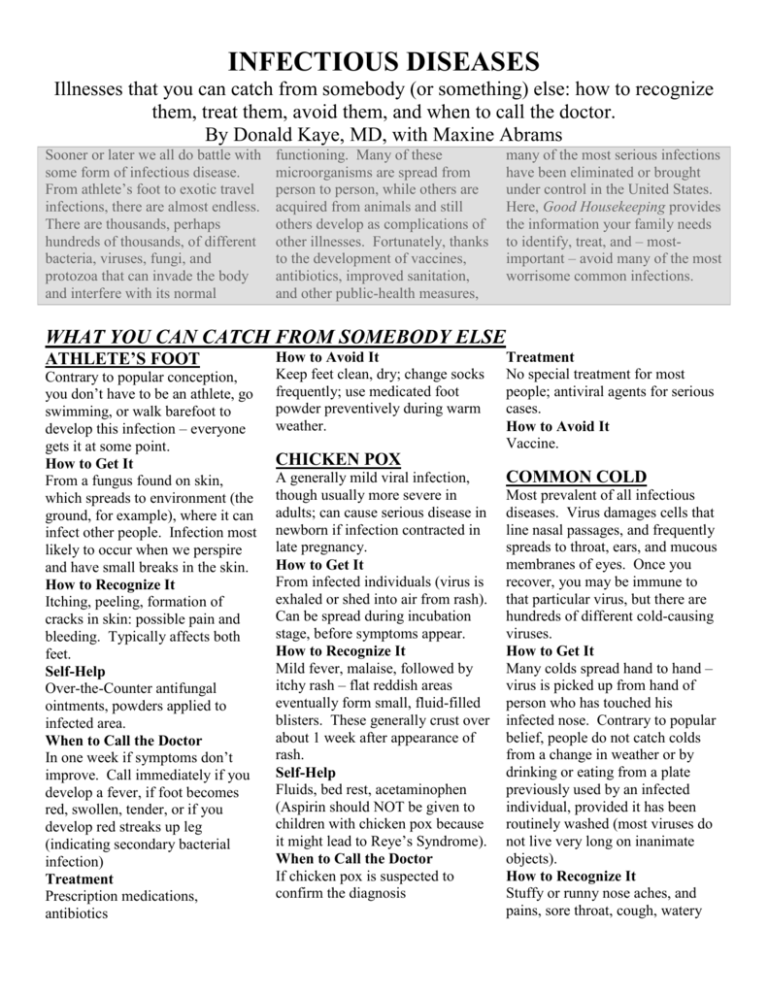
INFECTIOUS DISEASES Illnesses that you can catch from somebody (or something) else: how to recognize them, treat them, avoid them, and when to call the doctor. By Donald Kaye, MD, with Maxine Abrams Sooner or later we all do battle with some form of infectious disease. From athlete’s foot to exotic travel infections, there are almost endless. There are thousands, perhaps hundreds of thousands, of different bacteria, viruses, fungi, and protozoa that can invade the body and interfere with its normal functioning. Many of these microorganisms are spread from person to person, while others are acquired from animals and still others develop as complications of other illnesses. Fortunately, thanks to the development of vaccines, antibiotics, improved sanitation, and other public-health measures, many of the most serious infections have been eliminated or brought under control in the United States. Here, Good Housekeeping provides the information your family needs to identify, treat, and – mostimportant – avoid many of the most worrisome common infections. WHAT YOU CAN CATCH FROM SOMEBODY ELSE ATHLETE’S FOOT Contrary to popular conception, you don’t have to be an athlete, go swimming, or walk barefoot to develop this infection – everyone gets it at some point. How to Get It From a fungus found on skin, which spreads to environment (the ground, for example), where it can infect other people. Infection most likely to occur when we perspire and have small breaks in the skin. How to Recognize It Itching, peeling, formation of cracks in skin: possible pain and bleeding. Typically affects both feet. Self-Help Over-the-Counter antifungal ointments, powders applied to infected area. When to Call the Doctor In one week if symptoms don’t improve. Call immediately if you develop a fever, if foot becomes red, swollen, tender, or if you develop red streaks up leg (indicating secondary bacterial infection) Treatment Prescription medications, antibiotics How to Avoid It Keep feet clean, dry; change socks frequently; use medicated foot powder preventively during warm weather. Treatment No special treatment for most people; antiviral agents for serious cases. How to Avoid It Vaccine. CHICKEN POX A generally mild viral infection, though usually more severe in adults; can cause serious disease in newborn if infection contracted in late pregnancy. How to Get It From infected individuals (virus is exhaled or shed into air from rash). Can be spread during incubation stage, before symptoms appear. How to Recognize It Mild fever, malaise, followed by itchy rash – flat reddish areas eventually form small, fluid-filled blisters. These generally crust over about 1 week after appearance of rash. Self-Help Fluids, bed rest, acetaminophen (Aspirin should NOT be given to children with chicken pox because it might lead to Reye’s Syndrome). When to Call the Doctor If chicken pox is suspected to confirm the diagnosis COMMON COLD Most prevalent of all infectious diseases. Virus damages cells that line nasal passages, and frequently spreads to throat, ears, and mucous membranes of eyes. Once you recover, you may be immune to that particular virus, but there are hundreds of different cold-causing viruses. How to Get It Many colds spread hand to hand – virus is picked up from hand of person who has touched his infected nose. Contrary to popular belief, people do not catch colds from a change in weather or by drinking or eating from a plate previously used by an infected individual, provided it has been routinely washed (most viruses do not live very long on inanimate objects). How to Recognize It Stuffy or runny nose aches, and pains, sore throat, cough, watery eyes, clogged ears, and low-grade fever. Self-Help Over-the-Counter nose drops, spray, decongestants, aspirin, or acetaminophen. When to Call the Doctor If high fever, persistent cough, earache, or other severe symptoms develop. How to Avoid It Stay away from infected people (though this is relatively ineffective since virus excretion often precedes symptoms); wash hands if you touch someone with a cold. Nasal spray or interferon can prevent cold, but they are not yet approved or available and are very expensive. HEPATITIS Relatively common infection of the liver caused by many different viruses; 3 most serious forms of the disease are hepatitis A (infectious hepatitis); hepatitis B (serum hepatitis); and hepatitis non-A, non-B. How to Get It Hepatitis A: Primarily by eating or drinking fecally contaminated water or food. Largely a threat to travelers. Can be transmitted through oral-anal sex. Hepatitis B: Through sex or contaminated needles used by drug abusers or, for health workers, through contact with contaminated blood during dental/surgical procedures, accidental needle sticks. Hepatitis non-A, non-B: Through transfusions with contaminated blood (no screening test available) and possibly by sexual contact. May also be acquired in contaminated food. How to Recognize It Symptoms range from virtually no noticeable signs of illness to mild lethargy and loss of appetite to extreme exhaustion and jaundice – yellow skin, eyes, dark urine. When to Call the Doctor At once if jaundice develops. Treatment No specific therapy, rest, balanced diet. How to Avoid It Hepatitis A: Largely by watching what you eat and drink abroad. A single injection of gamma globulin before travel or after close contact with someone who has the disease can provide immunity. Hepatitis B: With vaccine prior to exposure, recommended for health-care professionals and others at high risk (such as male homosexuals), or by an injection of antibody shortly after exposure, followed by vaccination. Hepatitis non-A, non-B: no sure prevention, but gamma globulin may provide some protection. INFLUENZA Viral infection of the trachea and bronchial tubes. How to Get It By inhaling the virus. Infection most prevalent from January through April. How to Recognize It Acute onset of fever, dry cough, often accompanied by headache and muscular aches. Nasal symptoms, sore throat – if they occur – are minimal. Self-Help Aspirin, acetaminophen (children should not be given Aspirin – it might lead to Reye’s Syndrome); liquids, bed rest. When to Call the Doctor If no improvement after 2-3 days, if you begin to cough sputum, or if you take a turn for the worse after you have begun to fell better (you may have developed bacterial pneumonia). Treatment Same as self-help; antibiotics for bacterial complications. How to Avoid It Immunization against current strains of virus, given prior to season. The drug amantadine can provide protection while it is being taken, but because of side effects should be given only to those for whom disease could pose a serious threat. MONONUCLEOSIS Common disease caused by viral infection, generally mild. (Many of us have had “mono” during childhood or adolescence without knowing it.) Serious complications, which are rare, include anemia, a ruptured spleen (avoid contact sports), even a form of paralysis of infection involves brain or spinal cord. How to Get It Oral contact with infected individual. (Mono was dubbed the “kissing disease” when it was noted that male students developed infection 30 to 50 days after a vacation and were unlikely to spread it to their male roommates!) How to Recognize It Fever, sore throat, swollen glands in neck, armpit, and groin, general aches, fatigue. When to Call the Doctor For very high fever, severe sore throat, or symptoms that last more than a week. Doctor should rule out other more serious conditions. Treatment “Tincture of time”, bed rest if needed. How to Avoid It No prevention. PINWORMS Most common of intestinal worms. Worms about the size of a hair, lives in rectum, lays its eggs on anus at night. Occurs most frequently in small children. How to Get It By touching infected person, then putting hand in mouth or on food. Infection occurs commonly in children, who scratch their bottoms, then re-infect themselves by putting hands in mouth. Often passed to other family members. How to Recognize It Anal itching, mainly at night. When to Call the Doctor When child continually scratches himself in rectal area. Treatment Single dose of antiparasite medication. How to Avoid It With children, no practical way. When to Call the Doctor For any of these symptoms. Treatment Most patients with viral pneumonia recover on their own. Antibiotics cure most bacterial pneumonia, which are generally the most dangerous. How to Avoid It Immunization against influenza (which can lead to bacterial lung infections); pneumococcal vaccine, which protects against the most common form of bacterial pneumonia, recommended for the elderly, patients with underlying heart or lung disease, and people whose spleens have been removed. For any sore throat that lasts more than a week or if there is severe pain on swallowing, high fever, or markedly swollen neck glands. Treatment Self-help measure for viral sore throats. Penicillin for bacterial infections. How to Avoid It See “Common Cold”. VAGINAL INFECTIONS These infections most often caused by a protozoa (trichomonas), a fungus (candida), or by bacteria. How to Get It Trichomonas is usually transmitted sexually. Bacterial and yeast infections may or may not be; a THROAT INFECTION course of antibiotics or use of oral Most minor sore throats are caused contraceptives, for example, PNEUMONIA by viral infection; often as part of a increases susceptibility to yeast Infection of the lungs, caused by cold. Severe sore throats and infections. many different bacteria, viruses, tonsillitis may be caused by either a How to Recognize It protozoa, and fungi. Uncommon in bacterial infection (Streptococcus) Vaginal discharge (which may healthy young adults, but relatively or a virus. Strep sore throat should include pus and blood); itching and common n older or chronically ill not be neglected – it can lead to burning. individuals, alcoholics, and hospital abscesses around tonsils, middleWhen to Call the Doctor patients. With complications, can ear infections, even inflammation When symptoms become annoying. cause permanent damage to lungs. of kidneys or rheumatic fever. Treatment Specific antiprotozoan or antiyeast How to Get It How to Get It From an infected individual’s From others with colds. medications or antibiotics are used cough; or by inhaling bacteria that to treat different types of infections. Self-Help normally exist in your own mouth Throat lozenges, aspirin, or How to Avoid It or throat. acetaminophen (children should be For yeast infections, avoid oral given only acetaminophen because contraceptives and unnecessary How to Recognize It Fever plus cough with sputum of risk of Reye’s Syndrome). antibiotics; other vaginal infections production, blood in sputum, chest When to Call the Doctor can be avoided by use of condoms. pain, or shortness of breath. SEXUALLY TRANSMITTED DISEASES This large group of infections (STDs) ranges from mild, curable illnesses to some forms of hepatitis to the lethal AIDS. All are transmitted by sexual contact, often before carriers know they have an infection. Some untreated STDs can lead to infertility in women, as well as cause some complications during pregnancy. And in both sexes, untreated gonorrhea can spread through the blood stream into the joints; untreated syphilis can eventually lead to heart and nervous-system damage. It is important to see a doctor as soon as any problem is suspected. Most STDs can be readily treated. And of course it is also important to take proper precautionary measures: Select one’s sexual partners carefully and use condoms. Disease How to Recognize It Early symptoms include extreme fatigue, weight loss, fever, diarrhea, severe susceptibility to pneumonia, rare infections and forms of cancer. Discharge from vaginia or penis; pain during CLAMYDIA urination (but in women; often no symptoms). GENITAL WARTS Small warts in genital region (may be hidden in women). Discharge of pus from penis or vagina; painful GONORRHEA urination (but in women, often no symptoms). Painful blisters on genitals. HERPES AIDS SYPHILLIS Painless sores on genital or inside vagina. Treatment No cure, but various infections are treated as they arise. Antibiotics Topical medications; liquid nitrogen; laser surgery. Antibiotics Acyclovir, an antiviral agent (relieves symptoms, but virus remains in cells and infection may recur). Antibiotics DISEASES YOU CAN GET FROM ANIMALS How to Avoid It Stay away from stray or wild Lethal viral disease transmitted by animals, have your own pet contaminated saliva of infected immunized; don’t keep other animal. mammals (except rodents or How to Get It Disease occurs in many mammals – rabbits) as pets. If your pet has an encounter with wild animals, it may dogs, cats, bats, cows, raccoons, have contaminated saliva on body; foxes, skunks, wolves, and others. use gloves to chain or enclose pet; Unvaccinated household pets, then call veterinarian. especially those that roam freely and may be bitten by rabid animals, ROCKY MOUNTAIN can also be a source. Self-Help SPOTTED FEVER Following any bite, wound should Severe disease that infects the be washed thoroughly with soap lining of blood vessels throughout and water. the body. Mortality rate is 20% When to Call the Doctor without treatment, 5% with If animal is unvaccinated, stray, or treatment. (Disease not confined to you have been bitten by wild Rock Mountains – named for animal, trap animal if possible and laboratory in Rockies where call local health authorities. (They infectious organisms were first may or may not recommend rabies identified). treatment based on experience with How to Get It animal rabies in area.) From bite of “wood” tick or dog Treatment tick; pets can carry ticks into home. With antibody and new vaccine How to Recognize It (safer and less painful than old series). RABIES Fever, headache, followed in a few days by a red rash found mainly on arms and legs. When to Call the Doctor For any fever and rash during the tick season (late spring through early fall). Treatment Antibiotics – must be started promptly. How to Avoid It Check body for ticks carefully whenever you are in wooded areas during tick season, since bites don’t cause much pain and frequently occur on hairy parts of body, and since ticks are usually small – ranging from pinhead to pea size – they may go unnoticed. Also check children (most frequent victims of disease) and household pets. If you find a tick, use forceps or tweezers to grasp it close to the skin, then pull out the full tick (including the burrowed mouth). Dispose of in toilet. Wash skin with soap and water or disinfect with alcohol. OTHER CYSTITIS Fairly common infection of the bladder. Usually caused when bacteria that commonly exist in rectum and vagina are transferred to the bladder (as may occur during intercourse, but often happens spontaneously). More likely to afflict women because of their short urethras (tube that carries urine from the bladder out of the body). How to Recognize It Strong need to urinate; frequent urination often accompanied by pain, burning. When to Call the Doctor When the symptoms require medication for relief, or if you develop fever or pain along the sides of the middle back (kidney infection may be a complication). Treatment Sulfa drugs, some penicillins, tetracyclines, and many antibacterial agents. How to Avoid It Women who experience frequent attacks may benefit from urinating after intercourse so that bacteria are washed out of the bladder and urethra. DIARRHEA (Infectious) Although serious underlying medical problems, such as colitis, can cause diarrhea, most often the problem is a result of a viral, bacterial, or parasitic infection of the gastrointestinal tract. How to Get It From infectious organisms that may enter the body through contaminated food or water. How to Recognize It Semiformed or loose bowel movements passed at increased rate. Diarrhea caused by a viral infection may be accompanied by fever, vomiting, headache, and aching muscles. A more severe diarrhea caused by bacteria (for example Salmonella and Shigella), which invade the wall of the intestine, causing fever, cramps, pain on defecation, and pus or blood in stool. Parasitic infection causes diarrhea that may last for weeks, often with only low-grade or no fever. Self-Help Over-the-Counter antidiarrheal agents may control symptoms. Drink lots of slat- and sugarcontaining fluids. Eat if you are hungry – solid food will not “feed” your infection. When to Call the Doctor If there is no improvement with 2-3 days; if you develop a high fever, severe cramps, blood or pus in stool, pain on defecation, or it you begin to feel faint – a sign you are becoming dehydrated. Call sooner if diarrhea occurs in the very young or the elderly. Treatment Prescription anti-motility agents; specific antibiotics and antiparasitic drugs for bacterial and parasitic infections. How to Avoid It If you travel in tropics or developing countries, do not drink unboiled water, do not use ice cubes made from unboiled water, do not eat uncooked or unpeeled foods. At home, handle food safely. How to Recognize It Feeling of stuffiness in the ear, often accompanied by pain inside or behind ear. When to Call the Doctor Promptly if pain is severe. If allowed to progress, ear infection can permanently damage hearing, spread to mastoid bone, even infect brain. Treatment Usually antibiotics; sometimes ear must be drained through drum. How to Avoid It Never blow nose hard or while holding one nostril closed – you may blow mucus into Eustachian tubes. Never put anything in the ear, you may puncture the drum, making it easier for bacteria to enter the middle ear. SHINGLES Also known as herpes zoster. Caused by same virus that causes chicken pox. Virus remains – usually in latent form – inside nerve cells of the body, then after many years moves into the skin and causes the illness. How to Recognize It Usually by a 3-4 inch band of painful, tiny blisters on the skin on one side of the body. Rash usually disappears in several weeks, but pain can be severe and may persist long after rash is gone. When to Call the Doctor Whenever disease is suspected. Treatment EAR INFECTIONS Usually none. Antiviral agent and Although infections can occur in steroids in severe cases or when ear canal (often in swimmers), most eye is involved. serious infections involve middle How to Avoid It ear. Most seen in children. Chicken Pox Vaccine. How to Get It From blockage of drainage of the TOXIC SHOCK middle ear, frequently as a Syndrome first received national complication of a cold, tonsillitis, attention in 1980, when it caused a or sore throat. number of highly publicized deaths in young women. However, it is a relatively uncommon condition and occurs in both sexes and people of all ages. How to Get It From certain strains of Staphylococcus bacteria commonly found in nose and occasionally on skin and in vagina. Bacteria release toxin which can produce mild to very severe symptoms in susceptible individuals. Most reported cases have occurred during menstruation in young women wearing tampons (particularly superabsorbent varieties) for prolonged periods of time. How to Recognize It High fever accompanied by red rash all over body, falling blood pressure (manifested by lightheadedness), possible diarrhea, and vomiting. After 1 week, skin, especially on hands, peels. When to Call the Doctor Any time you develop a high fever and rash. Tampon users who develop any fever and/or rash during menstruation should remove tampon and see physician if improvement is not prompt. Treatment Intrvenous fluids, antibiotics in severe cases. How to Avoid It During menstruation, change tampon several time throughout day, wear pads at night. INFECTIOUS DISEASES NOBODY SHOULD GET ANY MORE The following diseases have been brought under control through development of effective vaccines. Diptheria Pertussis (Whooping Cough) Tetanus Measles Mumps Polio Rubella (German Measles)
